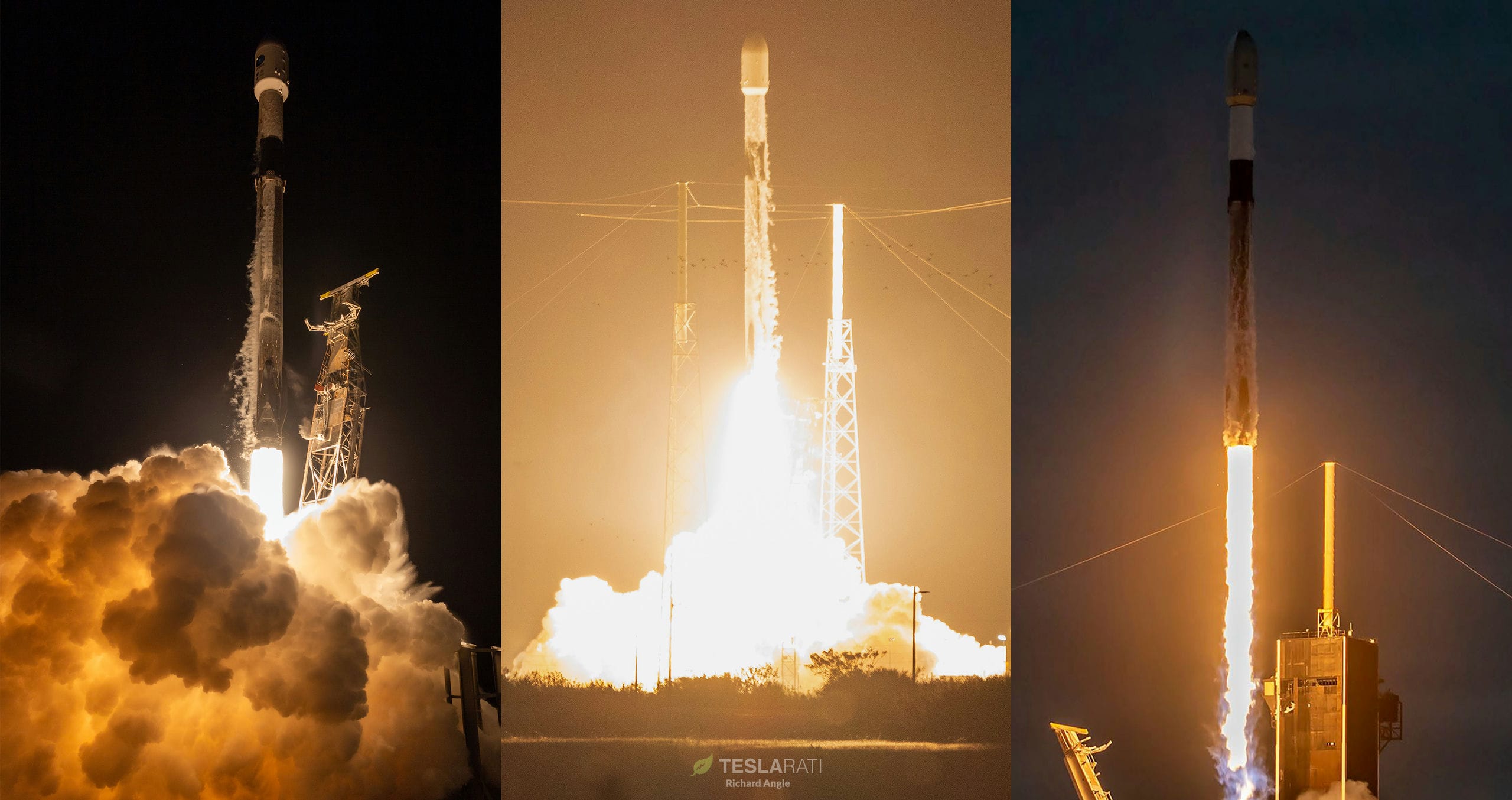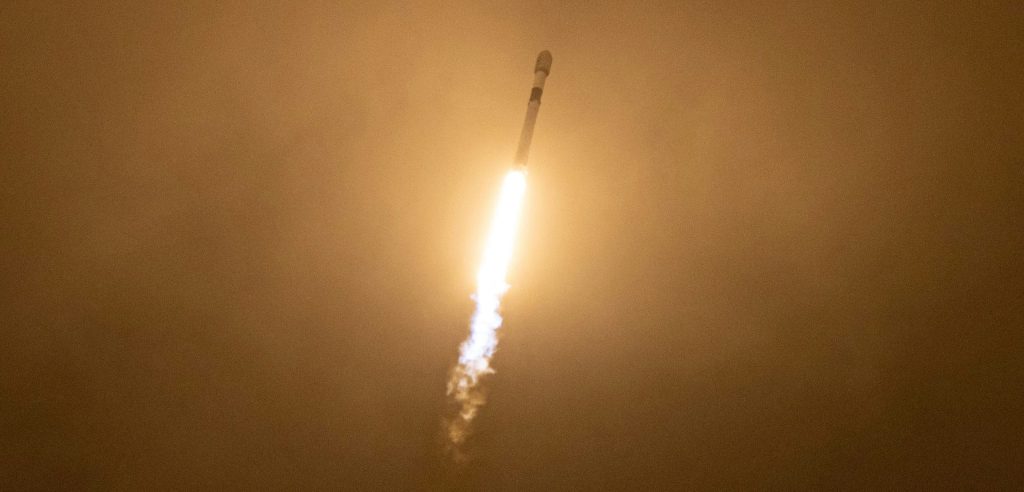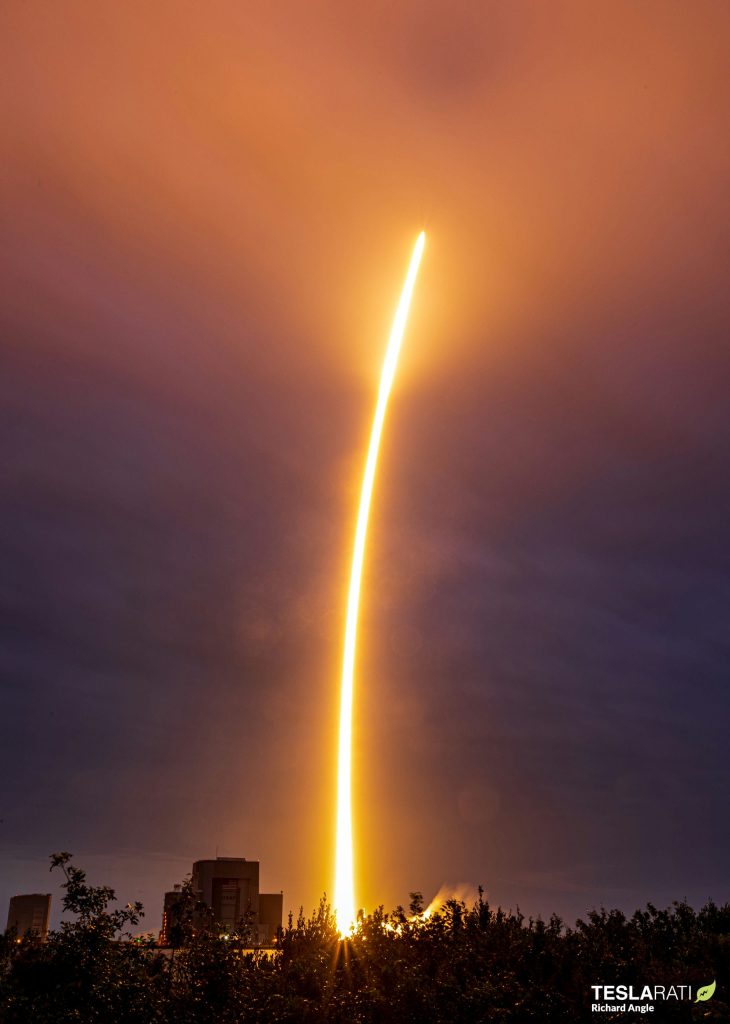

News
SpaceX aces three Falcon 9 launches in 34 hours
SpaceX has successfully launched three Falcon 9 rockets less than 34 hours apart, leaving the company only one mission shy of CEO Elon Musk’s ambitious target of 60 launches in 2022.
The period was almost even more intense, with two launches briefly scheduled minutes apart and all three set to launch in the space of 10-11 hours. But the more conservative sequencing SpaceX ultimately settled on still produced impressive results and allowed the company to break its own world record for the fastest time to complete three launches of the same rocket. In June 2022, SpaceX managed three similar launches – a Starlink mission, a scientific Earth observation satellite, and a commercial communications satellite – in 36 hours and 18 minutes.
Six months later, SpaceX has shaved more than two hours off of its own feat with the successful launches of another Earth observation satellite, a pair of commercial communications satellites, and 54 Starlink satellites in 33 hours and 46 minutes.
The update that's rolling out to the fleet makes full use of the front and rear steering travel to minimize turning circle. In this case a reduction of 1.6 feet just over the air— Wes (@wmorrill3) April 16, 2024
SpaceX’s latest hat trick began on December 16th with a Falcon 9 launch of the joint US-French Surface Water and Ocean Topography (SWOT) mission out of Vandenberg Space Force Base (VSFB), California. Delayed from December 12th and 15th, the launch was nonetheless a perfect success, placing the 2.2-ton (~4850 lb) radar satellite into a low Earth orbit that will allow it to precisely analyze virtually every inch of exposed water on Earth. That unprecedented capability should make it easier for scientists to study and understand Earth’s water cycle, as well as humanity’s substantial impact on those processes.
A little over 11 hours later, a second Falcon 9 rocket lifted off from SpaceX’s Cape Canaveral Space Force Station LC-40 pad carrying the first two Boeing-built O3b mPOWER satellites for satcom provider SES. Once again, SpaceX’s workhorse rocket did its job perfectly, even managing to exceed its contracted parameters according to SES CEO Steve Collar. Falcon 9’s better-than-expected performance will reduce the amount of time and propellant each 1.7-ton (~3750 lb) mPOWER satellite requires to reach its operational orbit, potentially ensuring a quicker path to revenue generation and longer useful lifespans.
SpaceX is on contract to launch all 11 initial mPOWER satellites. The next nine satellites will head to orbit sometime in 2023 and 2024 as Boeing completes them.


Finally, less than a day later after O3b mPOWER 1&2, a third Falcon 9 rocket lifted off from SpaceX’s NASA Kennedy Space Center LC-39A pad (just a few miles north of LC-40) with what could be the last full batch of “Group 4” Starlink V1.5 satellites. SpaceX’s first-generation Starlink constellation is comprised of five groups of satellites operating in distinct orbital ‘shells,’ and the company’s December 18th launch of Starlink 4-37 will leave SpaceX just 14 satellites away from fully finishing the second of two shells of 1584 satellites. All told, Starlink 4-37 was SpaceX’s 65th operational Starlink launch since November 2019 and the company likely has just ~20 launches to go to complete its first satellite constellation – already the largest in history by an order of magnitude.
All three launches were completed in less than a day and a half. Further emphasizing the breadth of SpaceX’s expertise, each Falcon 9 booster successfully landed after supporting their respective orbital launch, ensuring that those boosters will all be able to support more launches in the near future. In fact, Starlink 4-37 was the 15th mission for its Falcon 9 booster, B1058, breaking SpaceX’s internal reuse record and pushing the technology’s envelope. It remains to be seen if the company will push beyond 15 flights. In June 2022 interviews with Aviation Week, SpaceX executives stated that Falcon boosters would be retired after 15 flights – a big change from past indications that there was nothing preventing each booster from launching 100+ times with regular maintenance.
Starlink 4-37 was also SpaceX’s 59th successful orbital launch of 2022. In March, CEO Elon Musk raised an earlier annual target of 52 launches to 60 launches. At the time, 60 launches in one year was almost inconceivable. Set in 1980, the all-time record for a family of rockets (the Russian R-7) is 61 successful launches in one calendar year.
But against all odds, SpaceX has relentlessly executed week after week and sustained an average of one launch every six days for more than 12 months. Multiple sources currently indicate that SpaceX has two more Falcon 9 launches scheduled this year: another Starlink mission as early as December 28th and a mission carrying the Israeli EROS-C3 Earth imaging satellite on December 29th. SpaceX’s Falcon rocket family thus has a chance to tie the all-time record of 61 R-7 family launches, which was backed by the entire Soviet Union at the peak of its national launch cadence.
Elon Musk
Tesla reveals it is using AI to make factories more sustainable: here’s how
Tesla is using AI in its Gigafactory Nevada factory to improve HVAC efficiency.

Tesla has revealed in its Extended Impact Report for 2024 that it is using Artificial Intelligence (AI) to enable its factories to be more sustainable. One example it used was its achievement of managing “the majority of the HVAC infrastructure at Gigafactory Nevada is now AI-controlled” last year.
In a commitment to becoming more efficient and making its production as eco-friendly as possible, Tesla has been working for years to find solutions to reduce energy consumption in its factories.
For example, in 2023, Tesla implemented optimization controls in the plastics and paint shops located at Gigafactory Texas, which increased the efficiency of natural gas consumption. Tesla plans to phase out natural gas use across its factories eventually, but for now, it prioritizes work to reduce emissions from that energy source specifically.
It also uses Hygrometric Control Logic for Air Handling Units at Giafactory Berlin, resulting in 17,000 MWh in energy savings each year. At Gigafactory Nevada, Tesla saves 9.5 GWh of energy through the use of N-Methylpyrrolidone refineries when extracting critical raw material.
Perhaps the most interesting way Tesla is conserving energy is through the use of AI at Gigafactory Nevada, as it describes its use of AI to reduce energy demand:
“In 2023, AI Control for HVAC was expanded from Nevada and Texas to now include our Berlin-Brandenburg and Fremont factories. AI Control policy enables HVAC systems within each factory to work together to process sensor data, model factory dynamics, and apply control actions that safely minimize the energy required to support production. In 2024, this system achieved two milestones: the majority of HVAC infrastructure at Gigafactory Nevada is now AI-controlled, reducing fan and thermal energy demand; and the AI algorithm was extended to manage entire chiller plants, creating a closed-loop control system that optimizes both chilled water consumption and the energy required for its generation, all while maintaining factory conditions.”
Tesla utilizes AI Control “primarily on systems that heat or cool critical factory production spaces and equipment.” AI Control communicates with the preexisting standard control logic of each system, and any issues can be resolved by quickly reverting back to standard control. There were none in 2024.
Tesla says that it is utilizing AI to drive impact at its factories, and it has proven to be a valuable tool in reducing energy consumption at one of its facilities.
Elon Musk
Tesla analysts believe Musk and Trump feud will pass
Tesla CEO Elon Musk and U.S. President Donald Trump’s feud shall pass, several bulls say.

Tesla analysts are breaking down the current feud between CEO Elon Musk and U.S. President Donald Trump, as the two continue to disagree on the “Big Beautiful Bill” and its impact on the country’s national debt.
Musk, who headed the Department of Government Efficiency (DOGE) under the Trump Administration, left his post in May. Soon thereafter, he and President Trump entered a very public and verbal disagreement, where things turned sour. They reconciled to an extent, and things seemed to be in the past.
However, the second disagreement between the two started on Monday, as Musk continued to push back on the “Big Beautiful Bill” that the Trump administration is attempting to sign into law. It would, by Musk’s estimation, increase spending and reverse the work DOGE did to trim the deficit.
Every member of Congress who campaigned on reducing government spending and then immediately voted for the biggest debt increase in history should hang their head in shame!
And they will lose their primary next year if it is the last thing I do on this Earth.
— Elon Musk (@elonmusk) June 30, 2025
President Trump has hinted that DOGE could be “the monster” that “eats Elon,” threatening to end the subsidies that SpaceX and Tesla receive. Musk has not been opposed to ending government subsidies for companies, including his own, as long as they are all abolished.
How Tesla could benefit from the ‘Big Beautiful Bill’ that axes EV subsidies
Despite this contentious back-and-forth between the two, analysts are sharing their opinions now, and a few of the more bullish Tesla observers are convinced that this feud will pass, Trump and Musk will resolve their differences as they have before, and things will return to normal.
ARK Invest’s Cathie Wood said this morning that the feud between Musk and Trump is another example of “this too shall pass:”
BREAKING: CATHIE WOOD SAYS — ELON AND TRUMP FEUD “WILL PASS” 👀 $TSLA
She remains bullish ! pic.twitter.com/w5rW2gfCkx
— TheSonOfWalkley (@TheSonOfWalkley) July 1, 2025
Additionally, Wedbush’s Dan Ives, in a note to investors this morning, said that the situation “will settle:”
“We believe this situation will settle and at the end of the day Musk needs Trump and Trump needs Musk given the AI Arms Race going on between the US and China. The jabs between Musk and Trump will continue as the Budget rolls through Congress but Tesla investors want Musk to focus on driving Tesla and stop this political angle…which has turned into a life of its own in a roller coaster ride since the November elections.”
Tesla shares are down about 5 percent at 3:10 p.m. on the East Coast.
Elon Musk
Tesla scrambles after Musk sidekick exit, CEO takes over sales
Tesla CEO Elon Musk is reportedly overseeing sales in North America and Europe, Bloomberg reports.

Tesla scrambled its executives around following the exit of CEO Elon Musk’s sidekick last week, Omead Afshar. Afshar was relieved of his duties as Head of Sales for both North America and Europe.
Bloomberg is reporting that Musk is now overseeing both regions for sales, according to sources familiar with the matter. Afshar left the company last week, likely due to slow sales in both markets, ending a seven-year term with the electric automaker.
Tesla’s Omead Afshar, known as Elon Musk’s right-hand man, leaves company: reports
Afshar was promoted to the role late last year as Musk was becoming more involved in the road to the White House with President Donald Trump.
Afshar, whose LinkedIn account stated he was working within the “Office of the CEO,” was known as Musk’s right-hand man for years.
Additionally, Tom Zhu, currently the Senior Vice President of Automotive at Tesla, will oversee sales in Asia, according to the report.
It is a scramble by Tesla to get the company’s proven executives over the pain points the automaker has found halfway through the year. Sales are looking to be close to the 1.8 million vehicles the company delivered in both of the past two years.
Tesla is pivoting to pay more attention to the struggling automotive sales that it has felt over the past six months. Although it is still performing well and is the best-selling EV maker by a long way, it is struggling to find growth despite redesigning its vehicles and launching new tech and improvements within them.
The company is also looking to focus more on its deployment of autonomous tech, especially as it recently launched its Robotaxi platform in Austin just over a week ago.
However, while this is the long-term catalyst for Tesla, sales still need some work, and it appears the company’s strategy is to put its biggest guns on its biggest problems.
-

 Elon Musk1 day ago
Elon Musk1 day agoTesla investors will be shocked by Jim Cramer’s latest assessment
-

 News6 days ago
News6 days agoTesla Robotaxi’s biggest challenge seems to be this one thing
-

 News2 weeks ago
News2 weeks agoTesla’s Grok integration will be more realistic with this cool feature
-

 Elon Musk2 weeks ago
Elon Musk2 weeks agoElon Musk slams Bloomberg’s shocking xAI cash burn claims
-

 News2 weeks ago
News2 weeks agoTesla China roars back with highest vehicle registrations this Q2 so far
-

 News2 weeks ago
News2 weeks agoTesla dominates Cars.com’s Made in America Index with clean sweep
-

 News2 weeks ago
News2 weeks agoTexas lawmakers urge Tesla to delay Austin robotaxi launch to September
-

 Elon Musk1 week ago
Elon Musk1 week agoFirst Look at Tesla’s Robotaxi App: features, design, and more




















